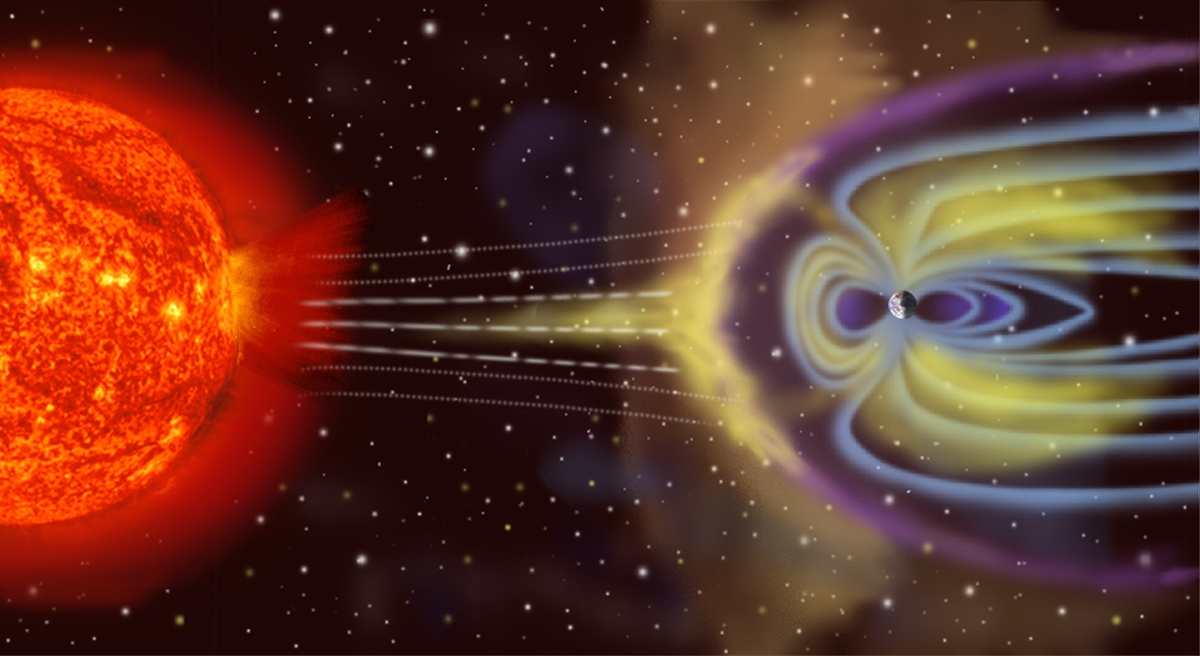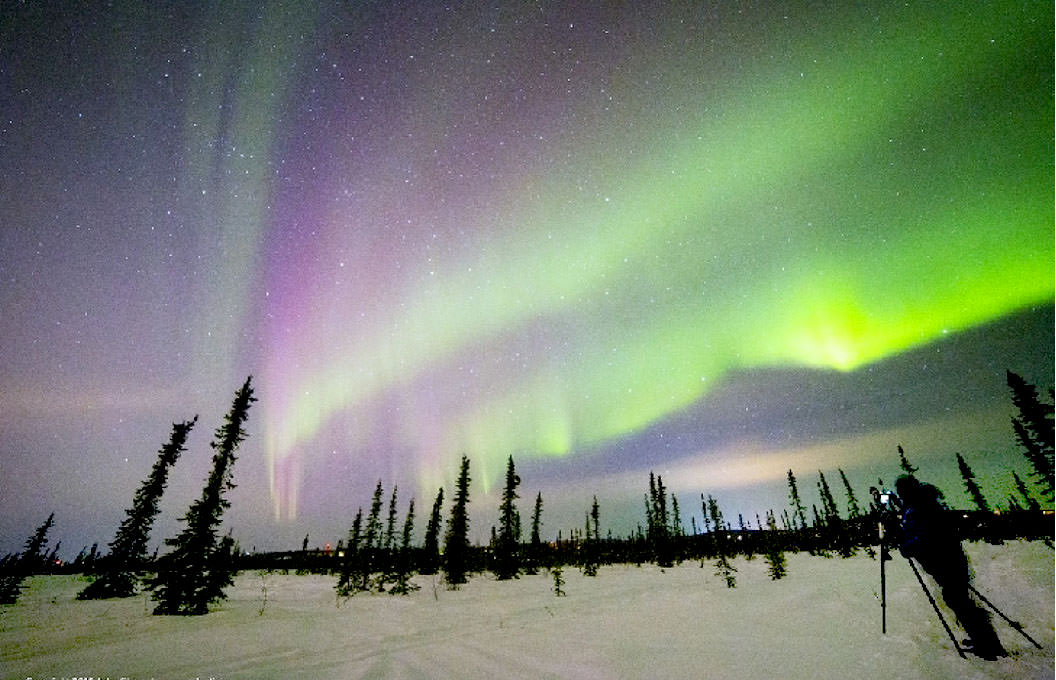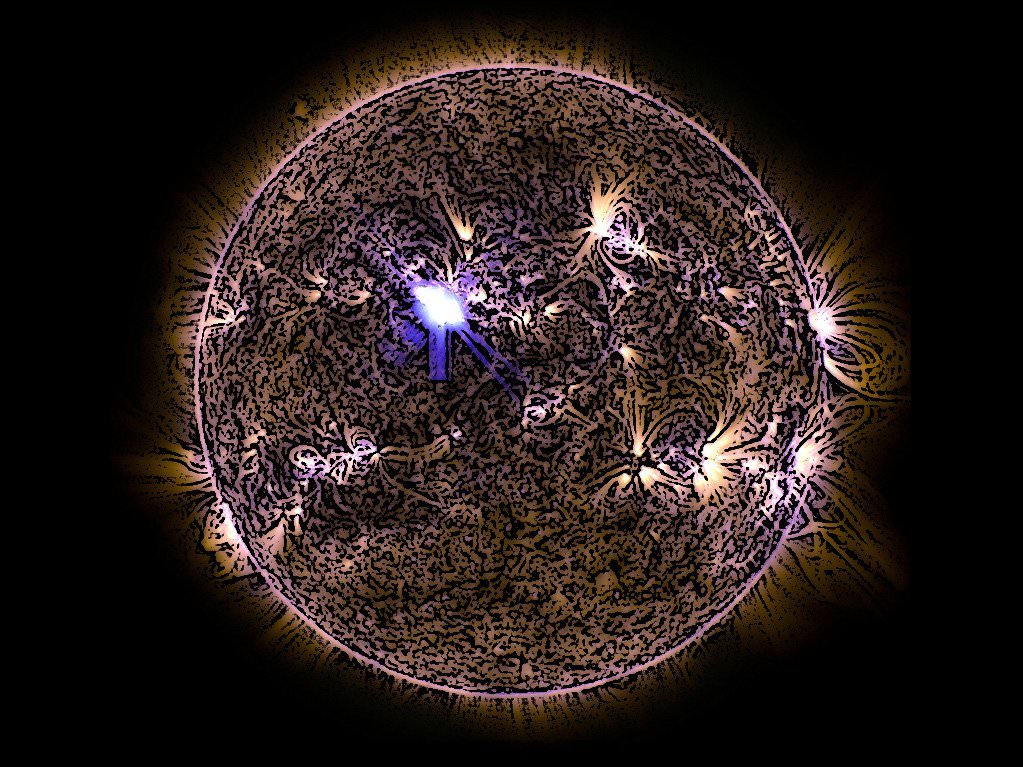Space is full of hazards. The Earth, and it’s atmosphere, does a great job of shielding us from most of them. But sometimes those hazards are more powerful than even those protections can withstand, and potentially catastrophic events can result. Some of the most commonly known potential catastrophic events are solar flares. While normal solar activity can be deflected by the planet’s magnetic field, resulting in sometimes spectacular auroras, larger solar flares are a danger to look out for. So it’s worth celebrating a team of researchers from the International Space Science Institute which found a way to better track these potentially dangerous natural events.
Continue reading “Scientists Have a new way to Predict the Most Damaging Solar Storms”A Very Powerful Solar Storm Hit the Earth Back in 1582
“A great fire appeared in the sky to the North, and lasted three nights,” wrote a Portuguese scribe in early March, 1582. Across the globe in feudal Japan, observers in Kyoto noted the same fiery red display in their skies too. Similar accounts of strange nighttime lights were recorded in Leipzig, Germany; Yecheon, South Korea; and a dozen other cities across Europe and East Asia.
It was a stunning event. While people living at high latitudes were well aware of auroras in 1582, most people living closer to the equator were not. The solar storm that year was unlike anything in living memory, and it was so strong it brought the aurora to latitudes as low as 28 degrees (in line with Florida, Egypt, and southern Japan). People this close to the equator had no frame of reference for such dazzling nighttime displays, and many took it as a religious portent.
Continue reading “A Very Powerful Solar Storm Hit the Earth Back in 1582”Unexpected Solar Flare is Also the Largest in Twelve Years
The past summer has been a pretty terrible time in terms of weather. In addition to raging fires in Canada’s western province of British Columbia, the south-eastern United States has been pounded by successive storms and hurricanes – i.e. Tropical Storm Emily and Hurricanes Franklin, Gert, Harvey and Irma. As if that wasn’t enough, solar activity has also been picking up lately, which could have a serious impact on space weather.
This past week, researchers from the University of Sheffield in the UK and Queen’s University Belfast detected the largest solar flare in 12 years. This massive burst of radiation took place on Wednesday, September 6th, and was one of three observed over a 48-hour period. While this latest solar flare is harmless to humans, it could pose a significant hazard to communications and GPS satellites.
The flare was also the eighth-largest detected since solar flare activity began to be monitored back in 1996. Like the two previous flares which took place during the same 48-hour period, this latest burst was an X-Class flare – the largest type of flare known to scientists. It occurred at 13:00 GMT (06:00 PDT; 09:00 EST) and was measured to have an energy level of X9.3.
Essentially, it erupted with the force of one billion thermonuclear bombs and drove plasma away from the surface at speeds of up to 2000 km/s (1243 mi/s). This phenomena, known as Coronal Mass Ejections (CMEs), are known to play havoc with electronics in Low Earth Orbit (LEO). And while Earth’s magnetosphere offers protection from these events, electronic systems on the planets surface are sometimes affected as well.
The event was witnessed by a team from a consortium of Universities, which included the University of Sheffield and Queen’s University Belfast. With the support of the Science and Technology Facilities Council, they conducted their observations using the Institute for Solar Physics‘ (ISP) 1-meter Swedish Solar Telescope, which is located at the Roque de los Muchachos Observatory – operated by the Instituto de Astrofisica de Canarias.
As Professor Mihalis Mathioudakis, who led the project at Queen’s University Belfast, indicated in a recent University of Sheffield press statement:
“Solar flares are the most energetic events in our solar system and can have a major impact on earth. The dedication and perseverance of our early career scientists who planned and executed these observations led to the capture of this unique event and have helped to advance our knowledge in this area.”
The team was able to capture the opening moments of a solar flare’s life. This was extremely fortunate, since one of the biggest challenges of observing solar flares from ground-based telescopes is the short time-scales over which they erupt and evolve. In the case of X-class flares, they are capable of forming and reaching peak intensity in just about five minutes.
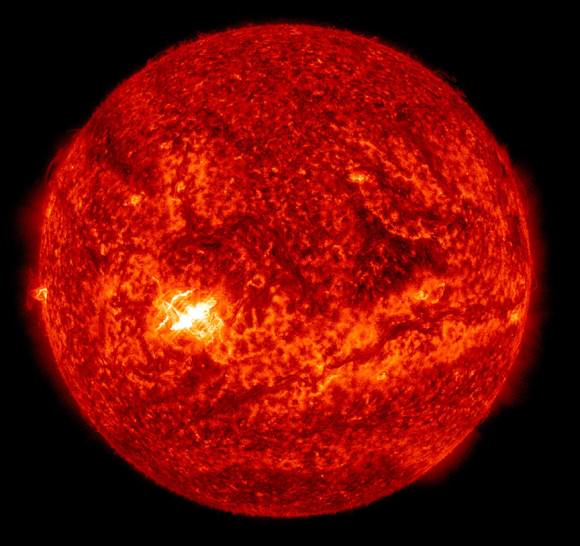
In other words, observers – who only see a small part of the sun at any one moment – must act very quickly to ensure they catch the crucial opening moments of a flare’s evolution. As Dr Chris Nelson, from the Solar Physics and Space Plasma Research Centre (SP2RC) – who was one of the observers at the telescope – explained:
“It’s very unusual to observe the opening minutes of a flare’s life. We can only observe about 1/250th of the solar surface at any one time using the Swedish Solar Telescope, so to be in the right place at the right time requires a lot of luck. To observe the rise phases of three X-classes over two days is just unheard of.”
Another interesting thing about this flare, and the two that preceded it, was the timing. At present, astronomers expected that we were in a period of diminished solar activity. But as Dr Aaron Reid, a research fellow at at Queen’s University Belfast’s Astrophysics Research Center and a co-author on the paper, explained:
“The Sun is currently in what we call solar minimum. The number of Active Regions, where flares occur, is low, so to have X-class flares so close together is very usual. These observations can tell us how and why these flares formed so we can better predict them in the future.”
Professor Robertus von Fáy-Siebenbürgen, who leads the SP2RC, was also very enthused about the research team’s accomplishment. “We at SP2RC are very proud to have such talented scientists who can make true discoveries,” he said. “These observations are very difficult and will require hard work to fully understand what exactly has happened on the Sun.”
Predicting when and how solar flares will occur will also aid in the development of early warning and preventative measures. The is part of growing industry that seeks to protect satellites and orbital missions from harmful electromagnetic disruption. And with humanity’s presence in LEO expended to grow considerably in the coming decades, this industry is expected to become worth several billion dollars.
Yes, with everything from small satellites, space planes, commercial habitats and more space stations being deployed to space, Low Earth Orbit is expected to get pretty crowded in the coming decades. The last thing we need is for vast swaths of this machinery or – heaven forbid! – crewed spacecraft, stations and habitats to become inoperative thanks to solar flare activity.
If human beings are to truly become a space-faring race, we need to know how to predict space weather the same we do the weather here on Earth. And just like the wind, the rain, and other meteorological phenomena, we need to know when to batten down the hatches and adjust the sails.
Further Reading: University of Sheffield
Solar Probe Plus Will ‘Touch’ The Sun
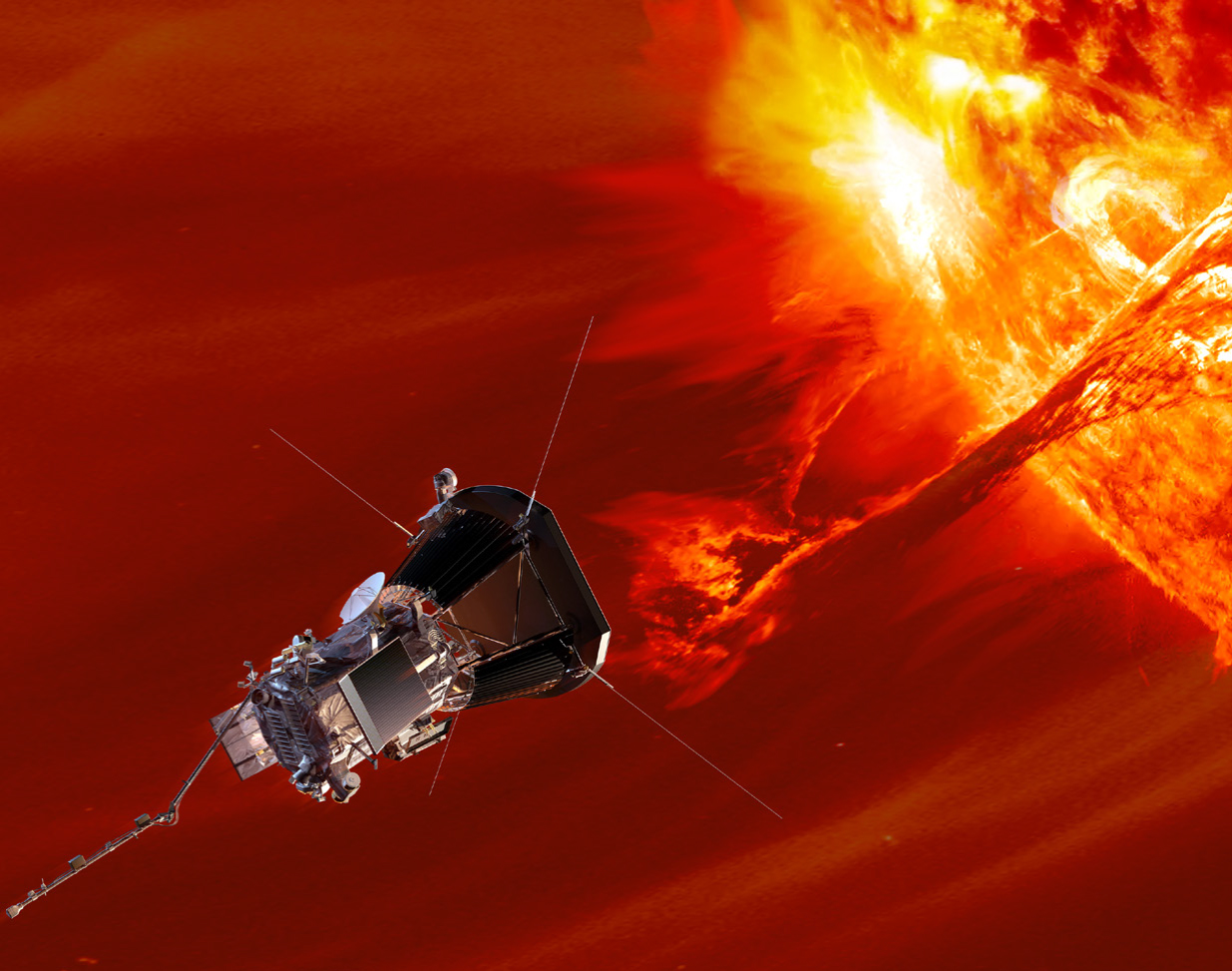
Coronal Mass Ejections (aka. solar flares) are a seriously hazardous thing. Whenever the Sun emits a burst of these charged particles, it can play havoc with electrical systems, aircraft and satellites here on Earth. Worse yet is the harm it can inflict on astronauts stationed aboard the ISS, who do not have the protection of Earth’s atmosphere. As such, it is obvious why scientists want to be able to predict these events better.
For this reason, the Smithsonian Astrophysical Observatory and the Charles Stark Draper Laboratory – a Cambridge, Massachusetts-based non-profit engineering organization – are working to develop specialized sensors for NASA’s proposed solar spacecraft. Launching in 2018, this spacecraft will fly into the Sun atmosphere and “touch” the face of the Sun to learn more about its behavior.
This spacecraft – known as the Solar Probe Plus (SPP) – is currently being designed and built by the Johns Hopkins University Applied Physics Laboratory. Once it is launched, the SPP will use seven Venus flybys over nearly seven years to gradually shrink its orbit around the Sun. During this time, it will conduct 24 flybys of the Sun and pass into the Sun’s upper atmosphere (corona), passing within 6.4 million km (4 million mi) of its surface.
At this distance, it will have traveled 37.6 million km (23.36 million mi) closer to the Sun than any spacecraft in history. At the same time, it will set a new record for the fastest moving object ever built by human beings – traveling at speeds of up to 200 km/sec (124.27 mi/s). And last but not least, it will be exposed to heat and radiation that no spacecraft has ever faced, which will include temperatures in excess of 1371 °C (2500 °F).
As Seamus Tuohy, the Director of the Space Systems Program Office at Draper, said in a CfA press release:
“Such a mission would require a spacecraft and instrumentation capable of withstanding extremes of radiation, high velocity travel and the harsh solar condition—and that is the kind of program deeply familiar to Draper and the Smithsonian Astrophysical Observatory.”
In addition to being an historic first, this probe will provide new data on solar activity and help scientists develop ways of forecasting major space-weather events – which impact life on Earth. This is especially important in an age when people are increasingly reliant on technology that can be negatively impacted by solar flares – ranging from aircraft and satellites to appliances and electrical devices.
According to a recent study by the National Academy of Sciences, it is estimated that a huge solar event today could cause two trillion dollars in damage in the US alone – and places like the eastern seaboard would be without power for up to a year. Without electricity to provide heating, utilities, light, and air-conditioning, the death toll from such an event would be significant.
As such, developing advanced warning systems that could reliably predict when a coronal mass ejection is coming is not just a matter of preventing damage, but saving lives. As Justin C. Kasper, the principal investigator at the Smithsonian Astrophysical Observatory and a professor in space science at the University of Michigan, said:
“[I]n addition to answering fundamental science questions, the intent is to better understand the risks space weather poses to the modern communication, aviation and energy systems we all rely on. Many of the systems we in the modern world rely on—our telecommunications, GPS, satellites and power grids—could be disrupted for an extended period of time if a large solar storm were to happen today. Solar Probe Plus will help us predict and manage the impact of space weather on society.”
To this end, the SPP has three major scientific objectives. First, it will seek to trace the flow of energy that heats and accelerates the solar corona and solar wind. Second, its investigators will attempt to determine the structure and dynamics of plasma and magnetic fields as the source of solar wind. And last, it will explore the mechanisms that accelerate and transport energetic particles – specifically electrons, protons, and helium ions.
To do this, the SPP will be equipped with an advanced suite of instruments. One of the most important of these is the one built by the Smithsonian Astrophysical Observatory with technical support from Draper. Known as the Faraday Cup – and named after famous electromagnetic scientists Michael Faraday – this device will be operated by SAO and the University of Michigan in Ann Arbor.
Designed to withstand interference from electromagnetic radiation, the Farady Cup will measure the velocity and direction of the Sun’s charged particles, and will be only two positioned outside of the SPP’s protective sun shield – another crucial component. Measuring 11.43 cm (4.5 inches) thick, this carbon composition shield will ensure that the probe can withstand the extreme conditions as it conducts its many flybys through the Sun’s corona.
Naturally, the mission presents several challenges, not the least of which will be capturing data while operating within an extreme environment, and while traveling at extreme speeds. But the payoff is sure to be worth it. For years, astronomers have studied the Sun, but never from inside the Sun’s atmosphere.
By flying through the birthplace of the highest-energy solar particles, the SPP is set to advance our understanding of the Sun and the origin and evolution of the solar wind. This knowledge could not only help us avoid a natural catastrophe here on Earth, but help advance our long-term goal of exploring (and even colonizing) the Solar System.
Further Reading: CfA
What Was the Carrington Event?
Isn’t modern society great? With all this technology surrounding us in all directions. It’s like a cocoon of sweet, fluffy silicon. There are chips in my fitness tracker, my bluetooth headset, mobile phone, car keys and that’s just on my body.
At all times in the Cain household, there dozens of internet devices connected to my wifi router. I’m not sure how we got to the point, but there’s one thing I know for sure, more is better. If I could use two smartphones at the same time, I totally would.
And I’m sure you agree, that without all this technology, life would be a pale shadow of its current glory. Without these devices, we’d have to actually interact with each other. Maybe enjoy the beauty of nature, or something boring like that.
It turns out, that terrible burning orb in the sky, the Sun, is fully willing and capable of bricking our precious technology. It’s done so in the past, and it’s likely to take a swipe at us in the future.
I’m talking about solar storms, of course, tremendous blasts of particles and radiation from the Sun which can interact with the Earth’s magnetosphere and overwhelm anything with a wire.
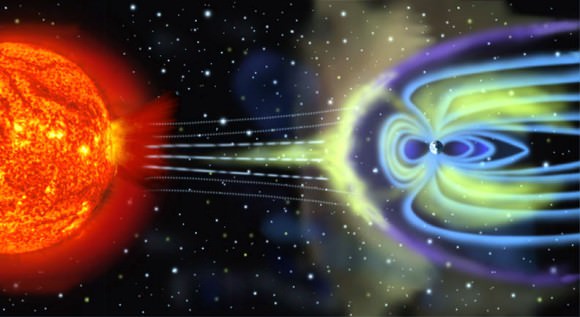
In fact, we got a sneak preview of this back in 1859, when a massive solar storm engulfed the Earth and ruined our old timey technology. It was known as the Carrington Event.
Follow your imagination back to Thursday, September 1st, 1859. This was squarely in the middle of the Victorian age.
And not the awesome, fictional Steampunk Victorian age where spectacled gentleman and ladies of adventure plied the skies in their steam-powered brass dirigibles.
No, it was the regular crappy Victorian age of cholera and child labor. Technology was making huge leaps and bounds, however, and the first telegraph lines and electrical grids were getting laid down.
Imagine a really primitive version of today’s electrical grid and internet.
On that fateful morning, the British astronomer Richard Carrington turned his solar telescope to the Sun, and was amazed at the huge sunspot complex staring back at him. So impressed that he drew this picture of it.
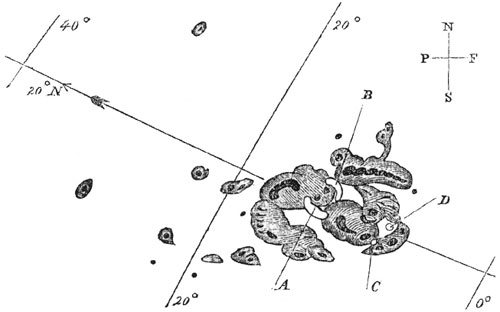
While he was observing the sunspot, Carrington noticed it flash brightly, right in his telescope, becoming a large kidney-shaped bright white flare.
Carrington realized he was seeing unprecedented activity on the surface of the Sun. Within a minute, the activity died down and faded away.
And then about 5 minutes later. Aurora activity erupted across the entire planet. We’re not talking about those rare Northern Lights enjoyed by the Alaskans, Canadians and Northern Europeans in the audience. We’re talking about everyone, everywhere on Earth. Even in the tropics.
In fact, the brilliant auroras were so bright you could read a book to them.
The beautiful night time auroras was just one effect from the monster solar flare. The other impact was that telegraph lines and electrical grids were overwhelmed by the electricity pushed through their wires. Operators got electrical shocks from their telegraph machines, and the telegraph paper lit on fire.
What happened? The most powerful solar flare ever observed is what happened.
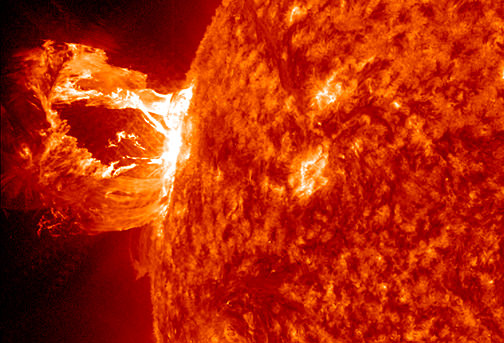
A solar flare occurs because the Sun’s magnetic field lines can get tangled up in the solar atmosphere. In a moment, the magnetic fields reorganize themselves, and a huge wave of particles and radiation is released.
Flares happen in three stages. First, you get the precursor stage, with a blast of soft X-ray radiation. This is followed by the impulsive stage, where protons and electrons are accelerated off the surface of the Sun. And finally, the decay stage, with another burp of X-rays as the flare dies down.
These stages can happen in just a few seconds or drag out over an hour.
Remember those particles hurled off into space? They take several hours or a few days to reach Earth and interact with our planet’s protective magnetosphere, and then we get to see beautiful auroras in the sky.
This geomagnetic storm causes the Earth’s magnetosphere to jiggle around, which drives charges through wires back and forth, burning out circuits, killing satellites, overloading electrical grids.
Back in 1859, this wasn’t a huge deal, when our quaint technology hadn’t progressed beyond the occasional telegraph tower.
Today, our entire civilization depends on wires. There are wires in the hundreds of satellites flying overhead that we depend on for communications and navigation. Our homes and businesses are connected by an enormous electrical grid. Airplanes, cars, smartphones, this camera I’m using.
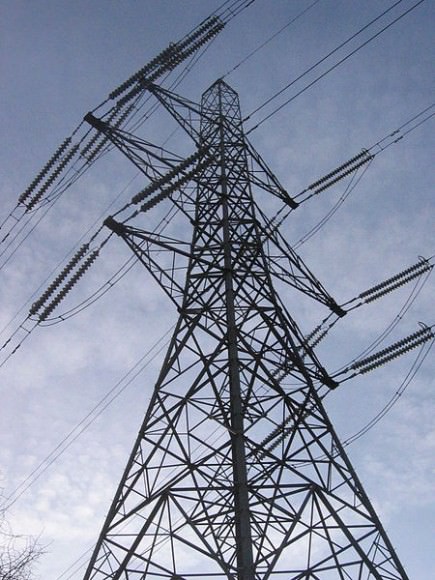
Everything is electronic, or controlled by electronics.
Think it can’t happen? We got a sneak preview back in March, 1989 when a much smaller geomagnetic storm crashed into the Earth. People as far south as Florida and Cuba could see auroras in the sky, while North America’s entire interconnected electrical grid groaned under the strain.
The Canadian province of Quebec’s electrical grid wasn’t able to handle the load and went entirely offline. For 12 hours, in the freezing Quebec winter, almost the entire province was without power. I’m telling you, that place gets cold, so this was really bad timing.
Satellites went offline, including NASA’s TDRS-1 communication satellite, which suffered 250 separate glitches during the storm.
And on July 23, 2012, a Carrington-class solar superstorm blasted off the Sun, and off into space. Fortunately, it missed the Earth, and we were spared the mayhem.
If a solar storm of that magnitude did strike the Earth, the cleanup might cost $2 trillion, according to a study by the National Academy of Sciences.
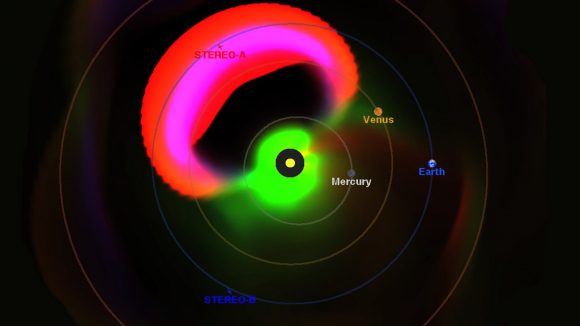
It’s been 160 years since the Carrington Event, and according to ice core samples, this was the most powerful solar flare over the last 500 years or so. Solar astronomers estimate solar storms like this happen twice a millennium, which means we’re not likely to experience another one in our lifetimes.
But if we do, it’ll cause worldwide destruction of technology and anyone reliant on it. You might want to have a contingency plan with some topic starters when you can’t access the internet for a few days. Locate nearby interesting nature spots to explore and enjoy while you wait for our technological civilization to be rebuilt.
Have you ever seen an aurora in your lifetime? Give me the details of your experience in the comments.
How Can You see the Northern Lights?
The Northern Lights have fascinated human beings for millennia. In fact, their existence has informed the mythology of many cultures, including the Inuit, Northern Cree, and ancient Norse. They were also a source of intense fascination for the ancient Greeks and Romans, and were seen as a sign from God by medieval Europeans.
Thanks to the birth of modern astronomy, we now know what causes both the Aurora Borealis and its southern sibling – Aurora Australis. Nevertheless, they remain the subject of intense fascination, scientific research, and are a major tourist draw. For those who live north of 60° latitude, this fantastic light show is also a regular occurrence.
Causes:
Aurora Borealis (and Australis) is caused by interactions between energetic particles from the Sun and the Earth’s magnetic field. The invisible field lines of Earth’s magnetoshere travel from the Earth’s northern magnetic pole to its southern magnetic pole. When charged particles reach the magnetic field, they are deflected, creating a “bow shock” (so-named because of its apparent shape) around Earth.
However, Earth’s magnetic field is weaker at the poles, and some particles are therefore able to enter the Earth’s atmosphere and collide with gas particles in these regions. These collisions emit light that we perceive as wavy and dancing, and are generally a pale, yellowish-green in color.
The variations in color are due to the type of gas particles that are colliding. The common yellowish-green is produced by oxygen molecules located about 100 km (60 miles) above the Earth, whereas high-altitude oxygen – at heights of up to 320 km (200 miles) – produce all-red auroras. Meanwhile, interactions between charged particles and nitrogen will produces blue or purplish-red auroras.
Variability:
The visibility of the northern (and southern) lights depends on a lot of factors, much like any other type of meteorological activity. Though they are generally visible in the far northern and southern regions of the globe, there have been instances in the past where the lights were visible as close to the equator as Mexico.
In places like Alaska, Norther Canada, Norway and Siberia, the northern lights are often seen every night of the week in the winter. Though they occur year-round, they are only visible when it is rather dark out. Hence why they are more discernible during the months where the nights are longer.
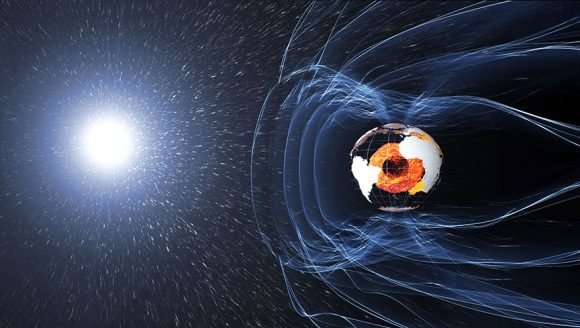
Because they depend on the solar wind, auroras are more plentiful during peak periods of activity in the Solar Cycle. This cycle takes places every 11 years, and is marked by the increase and decrease of sunspots on the sun’s surface. The greatest number of sunspots in any given solar cycle is designated as a “Solar Maximum“, whereas the lowest number is a “Solar Minimum.”
A Solar Maximum also accords with bright regions appearing in the Sun’s corona, which are rooted in the lower sunspots. Scientists track these active regions since they are often the origin of eruptions on the Sun, such as solar flares or coronal mass ejections.
The most recent solar minimum occurred in 2008. As of January 2010, the Sun’s surface began to increase in activity, which began with the release of a lower-intensity M-class flare. The Sun continued to get more active, culminating in a Solar Maximum by the summer of 2013.
Locations for Viewing:
The ideal places to view the Northern Lights are naturally located in geographical regions north of 60° latitude. These include northern Canada, Greenland, Iceland, Scandinavia, Alaska, and Northern Russia. Many organizations maintain websites dedicated to tracking optimal viewing conditions.
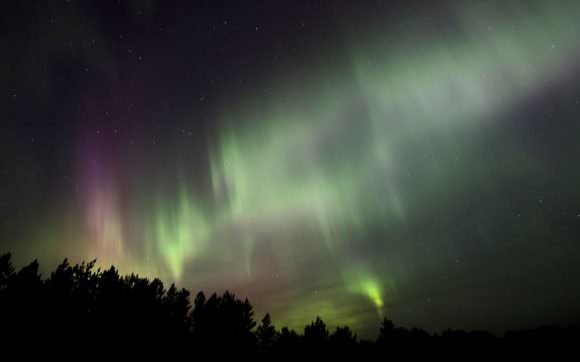
For instance, the Geophysical Institute of the University of Alaska Fairbanks maintains the Aurora Forecast. This site is regularly updated to let residents know when auroral activity is high, and how far south it will extend. Typically, residents who live in central or northern Alaska (from Fairbanks to Barrow) have a better chance than those living in the south (Anchorage to Juneau).
In Northern Canada, auroras are often spotted from the Yukon, the Northwest Territories, Nunavut, and Northern Quebec. However, they are sometimes seen from locations like Dawson Creek, BC; Fort McMurry, Alberta; northern Saskatchewan and the town of Moose Factory by James Bay, Ontario. For information, check out Canadian Geographic Magazine’s “Northern Lights Across Canada“.
The National Oceanic and Atmospheric Agency also provides 30 minute forecasts on auroras through their Space Weather Prediction Center. And then there’s Aurora Alert, an Android App that allows you to get regular updates on when and where an aurora will be visible in your region.
Understanding the scientific cause of auroras has not made them any less awe-inspiring or wondrous. Every year, countless people venture to locations where they can be seen. And for those serving aboard the ISS, they got the best seat in the house!
Speaking of which, be sure to check out this stunning NASA video which shows the Northern Lights being viewed from the ISS:
We have written many interesting articles about Auroras here at Universe Today. Here’s The Northern and Southern Lights – What is an Aurora?, What is the Aurora Borealis?, What is the Aurora Australis?, What Causes the Northern Lights?, How Does the Aurora Borealis Form?, and Watch Fast and Furious All-sky Aurora Filmed in Real Time.
For more information, visit the THEMIS website – a NASA mission that is currently studying space weather in great detail. The Space Weather Center has information on the solar wind and how it causes aurorae.
Astronomy Cast also has episodes on the subject, like Episode 42: Magnetism Everywhere.
Sources:
The Sun
The Sun is the center of the Solar System and the source of all life and energy here on Earth. It accounts for more than 99.86% of the mass of the Solar System and it’s gravity dominates all the planets and objects that orbit it. Since the beginning of history, human beings have understood the Sun’s importance to our world, it’s seasons, the diurnal cycle, and the life-cycle of plants.
Because of this, the Sun has been at the center of many ancient culture’s mythologies and systems of worship. From the Aztecs, Mayans and Incas to the ancient Sumerians, Egyptians, Greeks, Romans and Druids, the Sun was a central deity because it was seen as the bringer of all light and life. In time, our understanding of the Sun has changed and become increasingly empirical. But that has done nothing to diminish it’s significance.
Continue reading “The Sun”
Solar ‘Bombs’ And Mini-Tornadoes Spotted By Sun-Watching Spacecraft
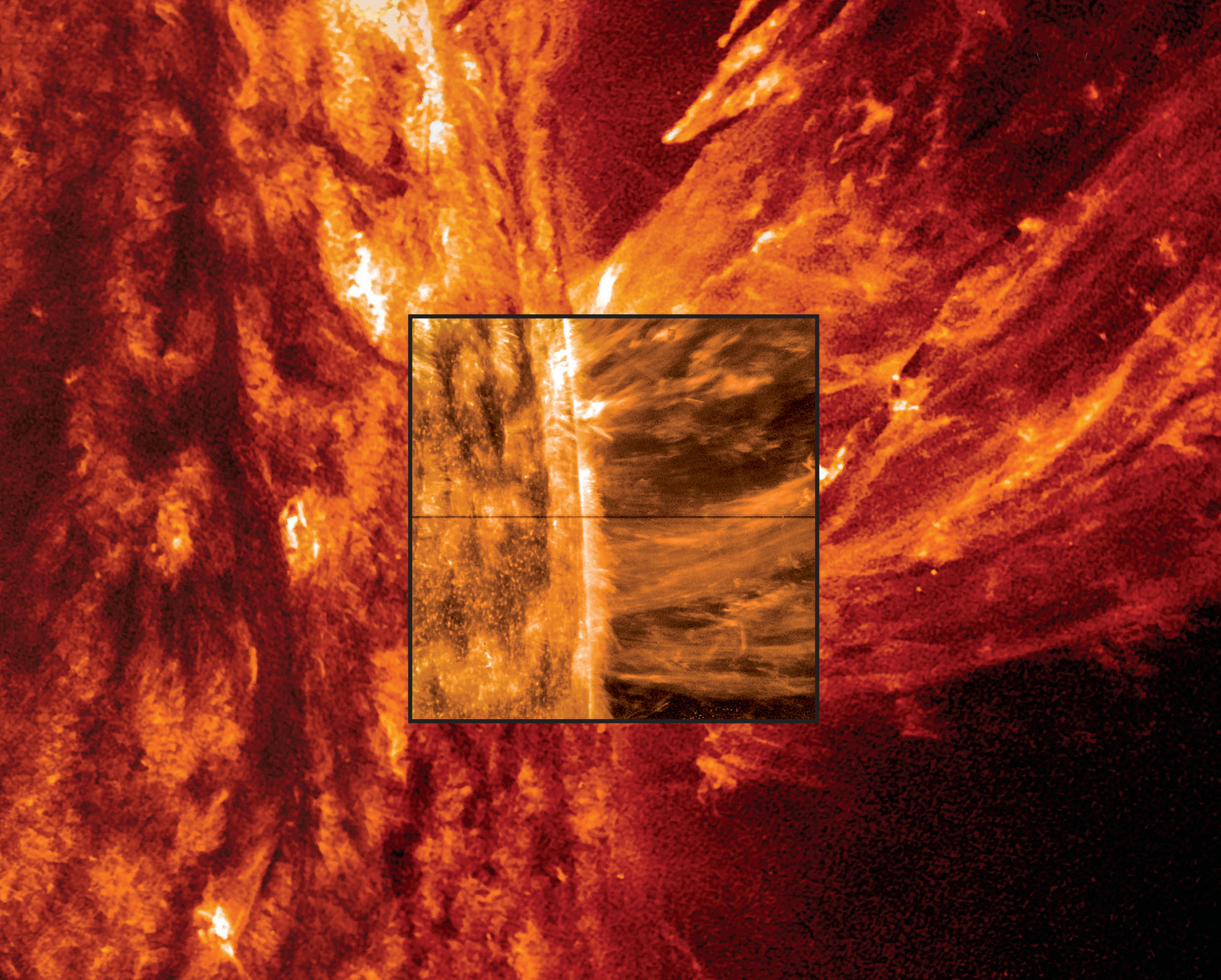
My, the Sun is a violent place. I mean, we knew that already, but there’s even more evidence for that using new data from a brand-new NASA spacecraft. There’s talk now about tornadoes and jets and even “bombs” swirling amid our Sun’s gassy environment.
A huge set of results from NASA’s Interface Region Imaging Spectrograph (IRIS) spacecraft reveals the true nature of a mysterious transition zone between Sun’s surface and the corona, or atmosphere. Besides the pretty fireworks and videos, these phenomena are telling scientists more about how the Sun moves energy from the center to the outskirts. And, it could tell us more about how stars work in general.
The results are published in five papers yesterday (Oct. 15) in Science magazine. Below, a brief glimpse of what each of these papers revealed about our closest star.
Bombs
This is a heck of a lot of energy packed in here. Raging at temperatures of 200,000 degrees Fahrenheit (111,093 degrees Celsius) are heat “pockets” — also called “bombs” because they release energy quickly. They were found lower in the atmosphere than expected. The paper is here (led by Hardi Peter of the Max Planck Institute for Solar System Research in Gottingen, Germany.)
Tornadoes
It’s a twist! You can see some structures in the chromosphere, just above the Sun’s surface, showing gas spinning like a tornado. They spin around as fast as 12 miles (19 kilometers) a second, which is considered slow-moving on the Sun. The paper is here (led by Bart De Pontieu, the IRIS science lead at Lockheed Martin in California).
High-speed jets

How does the solar wind — that constant stream of charged particles that sometimes cause aurora on Earth — come to be? IRIS spotted high-speed jets of material moving faster than ever observed, 90 miles (145 kilometers) a second. Since these jets are emerging in spots where the magnetic field is weaker (called coronal holes), scientists suspect this could be a source of the solar wind since the particles are thought to originate from there. The paper is here (led by Hui Tian at the Harvard-Smithsonian Center for Astrophysics in Massachusetts.)
Nanoflares
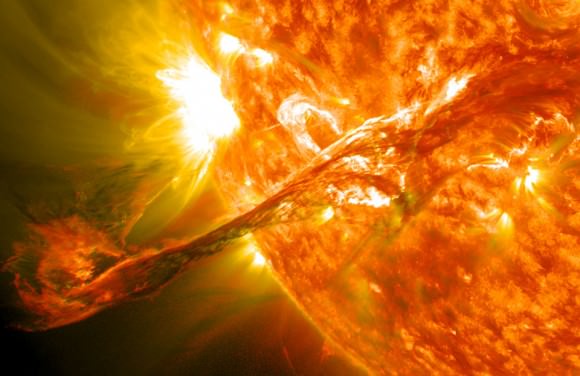
Those solar flares the Sun throws off happen when magnetic field lines cross and then snap back into place, flinging particles into space. Nanoflares could do the same thing to heat up the corona, and that’s something else that IRIS is examining. The paper is here (led by Paola Testa, at the Harvard-Smithsonian Center for Astrophysics.)
Structures and more
And here is the transition region in glorious high-definition. Improving on data from the Skylab space station in the 1970s (bottom of video), you can see all sorts of mini-structures on the Sun. The more we learn about these 2,000-mile (3,220-km) objects, the better we’ll understand how heating moves through the Sun. The paper is here (led by Viggo Hansteen, at the University of Oslo in Norway.)
Source: NASA
NASA Explains: The Difference Between CMEs and Solar Flares
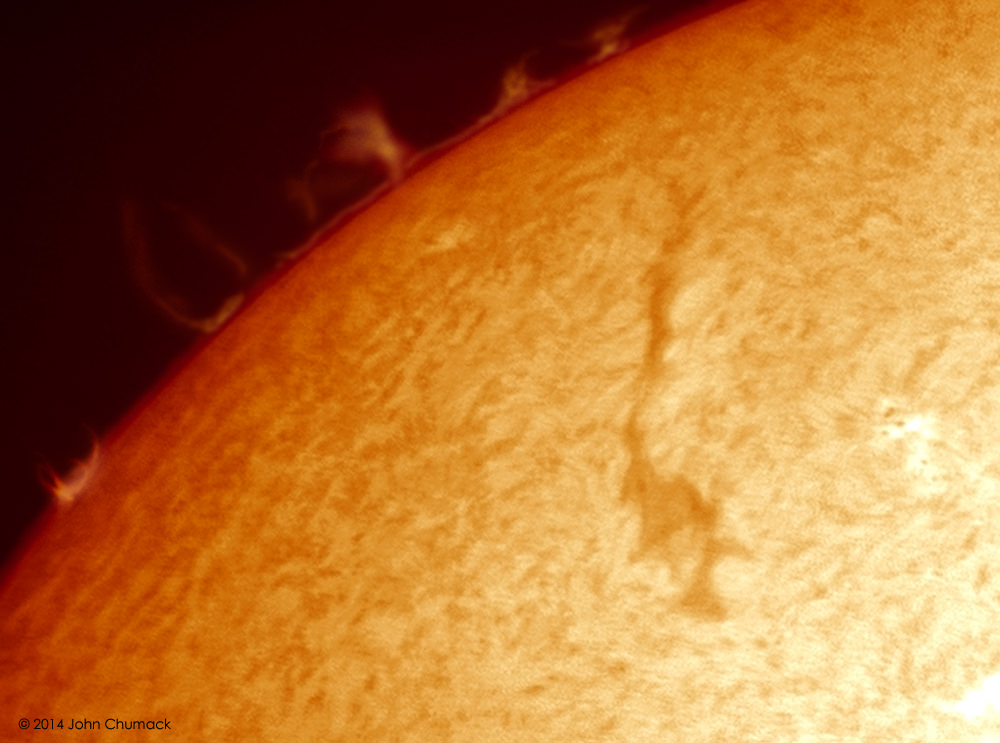
This is a question we are often asked: what is the difference between a coronal mass ejection (CME) and a solar flare? We discussed it in a recent astrophoto post, but today NASA put out a video with amazing graphics that explains it — and visualizes it — extremely well.
“CMEs and solar flares are both explosions that occur on the Sun,” the folks at NASA’s Goddard Spaceflight Center’s Scientific Visualization Studio explain. “Sometimes they occur together, but they are not the same thing.”
CMEs are giant clouds of particles from the Sun hurled out into space, while flares are flashes of light — occurring in various wavelengths — on the Sun.
You can find even more details from NASA here.
Astrophoto: The Sun as a Work of Art
Here’s a solar flare with a little flair added! Astrophotographer Rick Ellis from Toronto, Canada created this “artsy” Sun by using a series of photoshop filters and effects with a combination of two images from the Solar Dynamics Observatory taken on April 12, 2013. He tinkered with the contrast at specific color ranges, applied “equalization,” and used a filter called “accented edges.”
“Then I posterized it and ran it through the “posterize edges” filter which really brings out many details,” Rick said via email.
Rick admitted to some confusion about the difference between solar flares and coronal mass ejections, and so we figured this might be a good time to explain. They do have several similarities, however: both solar flares and CMEs are energetic events on the Sun that are both associated with high energy particles, and they both depend on magnetic fields on the Sun.
In the case of a CME, coronal material is ejected into space at high speeds. According to Berkeley University the most obvious difference between a solar flare and a CME is the spatial scale on which they occur.
“Flares are local events as compared to CMEs which are much larger eruptions of the corona,” says the Berkeley webpage, and sometimes a CME can be larger than the Sun itself. Solar flares and coronal mass ejections often occur together, but each can also take place in the absence of the other.
Want to get your astrophoto featured on Universe Today? Join our Flickr group or send us your images by email (this means you’re giving us permission to post them). Please explain what’s in the picture, when you took it, the equipment you used, etc.


